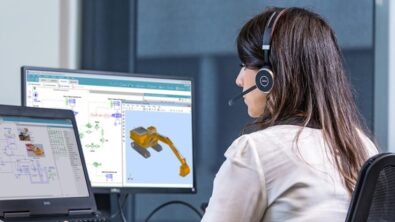Drive efficiencies across all disciplines with model based systems engineering for heavy equipment

Hear from Siemens experts in this on-demand webinar as they guide heavy equipment manufacturers on how to get started with their own custom model based systems engineering journey.
Electrification and digital innovations,
Connected equipment,
Unique customer requests,
The heavy equipment industry is witnessing major trends that necessitate product innovation to maintain competitiveness. In addition, regulations and environmental concerns are redefining product requirements, which in turn calls for dramatic changes to the development process.
This transition requires a robust integration of Model Based Systems Engineering (MBSE) into every aspect of product design and engineering to ensure quality, cost-efficiency, and availability. The significance of systems engineering in product development is critical when considering the complexities of modern products and the way they interact with other systems in their surroundings.
Heavy equipment manufacturing teams can design complex machines more efficiently and with less risk by embracing an MBSE approach.
Why model based systems engineering starts with an integrated product architecture
When relying on document-based methods, between 30-70% of program schedule and resource time can be consumed by integration issues. The result? A traffic jam in your product development process that costs money and sets you back as a competitor in the global market.
So how do you overcome these bottlenecks and go from an unscalable “spec-design-build” approach, to an “integrate THEN build” process? This transition is not merely a shift in technology but requires a systemic change in thinking, tooling, and organizational processes.
In this short clip from the Siemens webinar “MBSE for heavy equipment”, Systems Engineering Evangelist Mark Sampson talks about why model based systems engineering is a journey, not a tool:
Siemens and IBM: Breaking down silos and creating a comprehensive digital twin
Organizational silos are recognized as a significant barrier to efficient product development, where the absence of a single source of truth leads to challenges in traceability and the assessment of change impact. With the rapid evolution of components, systems, and products, particularly in industries such as heavy equipment, the need for a unified approach to product development becomes increasingly critical.
In this context, embracing MBSE is essential to overcoming the constraints imposed by silos. Working on multidisciplinary models and having a single source of truth and are imperative for ensuring high-quality product development, cost efficiency, and timely market entry.
In this short video clip, Mark Sampson introduces how a Siemens and IBM partnership allows you to see the impact of change not only on product structures but in the software as well to continuously verify and validate:
Taking an MBSE approach throughout the product lifecycle is critical to ensuring that the right information is delivered at the right time. This approach promises enhanced efficiency, reduced integration issues, and increased product availability. The strategic partnership between industry leaders further facilitates this integration, extending MBSE’s benefits across the supply chain.
The benefits of MBSE for heavy equipment customers
In many industries, OEMs use MBSE in their engineering processes, but how exactly can heavy equipment companies take advantage of this approach? MBSE is intended to help manufacturers avoid future problems rather than saving money you’re already spending.
In this short clip, Mark provides an example of a multi-billion dollar product and how MBSE enabled continuous communication and integration from the start, savings billions in costs with faster production and fewer delays:
Watch the full recording of this on-demand webinar to learn the value of integrated systems engineering and requirements management and how this approach can smooth out your development process to enable continuous system integration.

Ready to start your custom MBSE journey?
Learn more about how Siemens can help heavy equipment manufacturers jump-start their MBSE journey here: Model-based systems engineering for Heavy Equipment
Check out this collection of MBSE heavy equipment resources to learn more about integrated system engineering solutions.
Comments
Leave a Reply
You must be logged in to post a comment.



Download Fake usdt flasher software